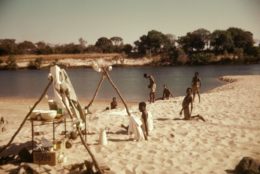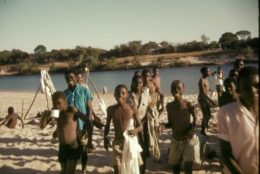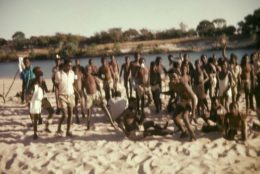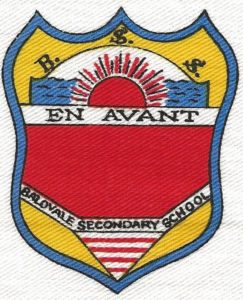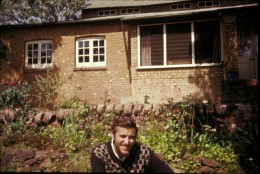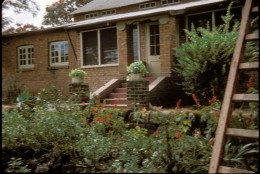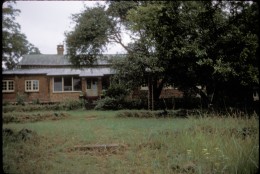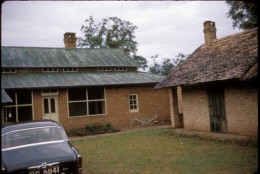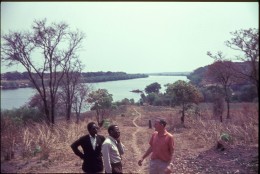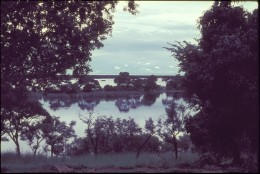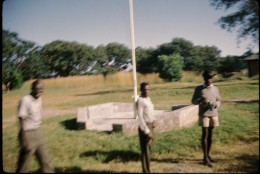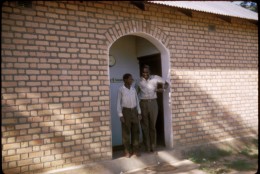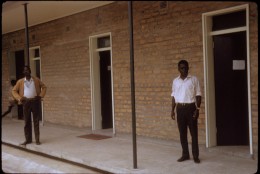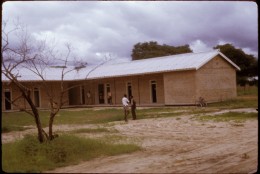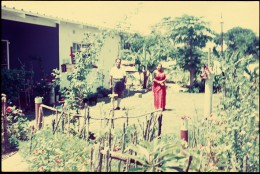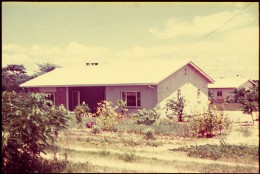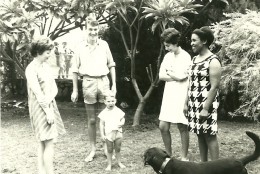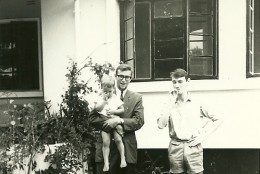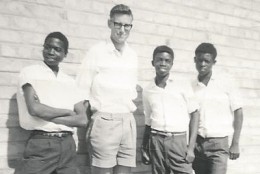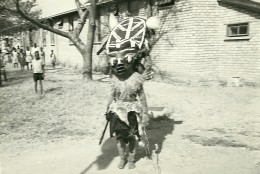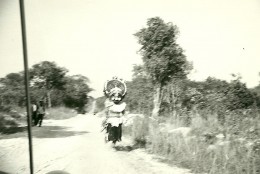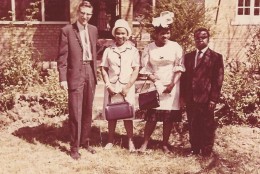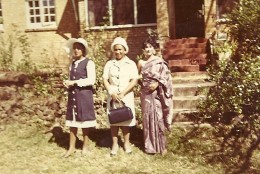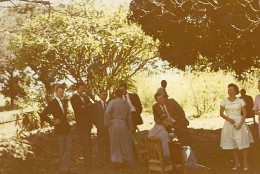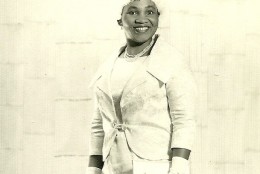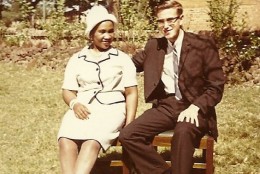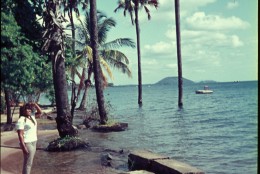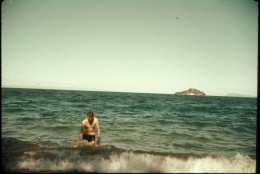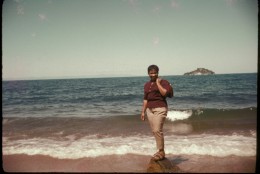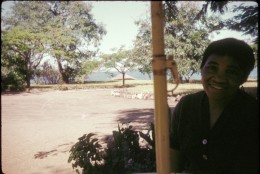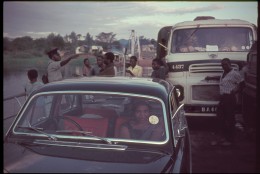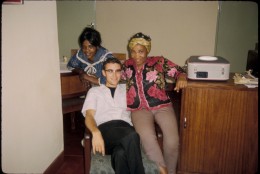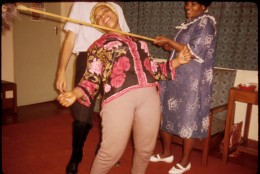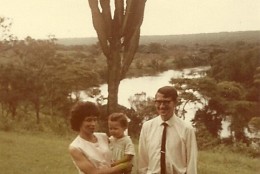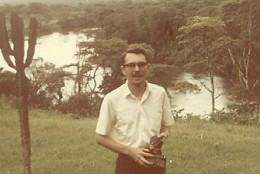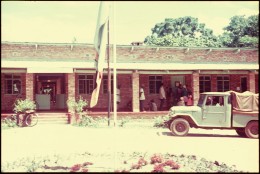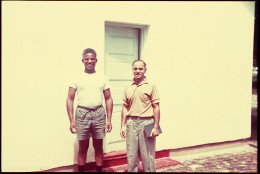Zambezi (Balovale) Secondary School: 1965-68 — a school transfer that changed my life
Falling in love with Zambezi and transferring from Solwezi
Why this transfer? It occurred because of two visits that I made with Thomas Samungole, first in August 1964 and the second in October 1964 during Zambia’s Independence celebrations. (These were described at the end of the previous web page on Solwezi.) During these visits, I fell deeply in love with the people, the school area, the town and the whole district that stretched up and down the Zambezi River.
Transferring to the new school. Since a new secondary school would open in early 1965, I applied for a transfer as a teacher. Thomas Samungole, who finished his final secondary school examinations in December 1964, liked the idea of being a student teacher for a year in his home district. (Although my student, we are the same age.) Thus, we submitted applications on our return to Solwezi after the August visit. Within a few weeks, we were notified that I was being transferred as of 1 January 1965 and that Thomas was also being appointed. Although I asked to go to Balovale simply as a teacher, as I was only 26 at the time, the Ministry said I would be acting head of the new school. They were acutely short of teachers and headmasters, as several new secondary schools were opening around the new country in January 1965. Although not keen to be an administrator, I reluctantly accepted this new status.
At the Zambezi River beach in Oct. 1965. Who do you recognize?!
Click on a picture to enlarge it
Balovale School Logo for school uniforms
The initial physical facilities of the new secondary school, including my amazing first house.
The new Secondary School opened in old trade school buildings. In January 1965, when I opened the secondary school, new buildings had not yet been built. Thus, my initial home and other school structures were inherited from the old trade school that had been on the site for probably two decades. Some of these buildings, however, even stretched back to the days of the missionaries, who had built on the site before roads reached the area from the west. New school structures buildings would be completed during the next three years.
My initial house had an amazing view overlooking a bend of the Zambezi River. I moved into the house that Mr. Furst, the last head of the Trades School had just left weeks before. Possibly 50 years old, it had been built as hotel. Overlooking a major bend of the Zambezi River, south of Balovale town, it was built by Brethren missionaries as a stopping point for travel up and down the Zambezi River. Prior to roads, travel up and down the Zambezi River from Livingstone was the main entree north to Balovale and eastern Angola. The best time for travel on the river was April to August when the Zambezi River was flooding. The house had 17 rooms and while totally charming, it was slowly falling apart. Note: the crude drawing below of the house, made on 31 Jan. 1965 — added to the website on 12th May 2018 after located it in a letter to my family. Click to enlarge it.
Despite the disadvantages of its age, from the front of the house the views of the Zambezi River were exquisite — almost unbelievable. Fabulous memories remain. Please note: the photo of the Zambezi in flood at the top of every page on the website, as well as those below, were taken from the front of this home where I, and later Zindi, lived for over a year.
Enormous challenges in operating the new school
The initial intake of students. The new secondary school had an initial intake of 70-80 students. Mr. Kakwisa from the old trade school stayed as a carpentry teacher for the new school and also served as the school’s boarding master. He remained in his old staff house and Mr. Samungole occupied a house next to his. We maintained large gardens at the school to help us with fresh produce. Most food, especially maize meal (mealie-mealie), had to brought in from the Copperbelt, 500 km from the east over roads that could be next to impassable during the latter part of the rainy season from January to April of each year. Major logistical challenges were built into the future developments.
One of the greatest challenges of my whole life. Opening and then making the school run was one of the two greatest challenges in my whole life. (The other would later be completing my Ph.D. in the early 1980s.) Besides Thomas Samungole, Mr. Kakwisa and myself, the new government was unable to provide other teachers to open the new school. Fortunately, a middle-aged Brethren missionary, Mrs. McQuillen, who was a trained mathematics teacher and lived in the town just several kilometres away, was willing to teach half time. Only in mid-year did we get another teacher from England (Mr. Lycett), who soon proved to be extremely unsatisfactory. Later in the year, we got several graduate student teachers from the UK. We were given a lorry to get firewood for operating a kitchen that fed the school-boys. But problems were just starting as getting petrol (gasoline) became increasingly difficult with the Rhodesian boycott began to hit Zambia’s economy.
Old headmaster’s home and the Zambezi River views
- Front of house w/David
- Old H/M’s house up close
- H/M closer to the River
- H/M’s old from the river
- Back of H/M’s house
River views from original H/M’s Home
- Messrs. Samungole, Banda & Furth (10/64)
- Zambezi River after rains have started
- Zambezi River in full flood (April)
Staff members, new homes and old and new buildings
- Outside old office
- Jonas & Mr. Kakwisa at old office
- New office & Mr. G. Musumali
- New classrooms
- New staff housing: Mr/Mrs. Chako
- H/M’s new house
Zindi & David with ZSS staff members in early 1968
(taken in Ndola just before we left for America and after the
MacIntyre family had just transferred to the Copperbelt)
- Lothian House in Kitwe: gov’t hostel
- Gloria Tanner, the MacIntyre family and Zindi
- David and Mac
One more picture of school-boys and me, plus two pictures of a makishi visiting ZSS and on the main road
- Eddie Kalela, me, Godfrey Mukuma & Ronald Chikasa
- Makishi visiting ZSS
- Makishi on the main road
Zindi and David: Key participants in Zambezi’s “wedding of the year”!
At the Independence celebrations in October 1964, I met Zindi, one of Balovale’s three nurses (R.N.s) at that time. All three were refugees from the old apartheid South Africa. While getting the school going in early 1965, I saw Zindi Miriam Nondumiso Gqomo again many times in town and at the private club. After a very short romance, Zindi and I were married on 10th April 1965. This caused quite a sensation as interracial marriage, even among expatriates was still very controversial
Paul David Wilkin and Zindi Miriam Nondumiso Gqomo
- David, Zindi, Putusi Appolos, & Dr. Harry Bwanausi
- Ethel Bwanausi, Zindi & Mrs. Ramkasun
- Wedding guests in front yard
- Zindi’s offical wedding photo taken in Kitwe
- Zindi and David at the wedding celebration
David and Zindi’s Honeymoon: Traveling to Lake Malawi
We decided to honeymoon in Malawi on the school holiday from mid-April to late June. We set off in our Volvo and drove to Lusaka and then north to the Tanzania border at what was then Abercorn (now Mbala). We then headed southeast into Malawi. In hindsight, the trip into Malawi was very foolish as she had no travel documents to travel outside Zambia. Worse yet, our marriage certificate bore the name of Dr. Harry Bwanausi, who at that time was in Zambia as a Malawian refugee because of his opposition to Dr. K. Banda, Malawi’s President. Immediately, we were given seven days to leave the country. Still, we used this time to enjoy the shores of beautiful Lake Malawi before heading back to Balovale/Zambezi via Lusaka and the Copperbelt.
- Beaches of Lake Malawi
- David swimming in Lake Malawi
- Beaches of Lake Malawi
- Beaches of Lake Malawi
- Beaches of Lake Malawi
- Zindi in the Volvo on a pontoon (eastern Zambia)
- Zindi overlooking the escarpment in eastern Zambia
- Back in Zambezi: Putusi, David & Zindi
- At home: Practicing the limbo which was in fashion
The secondary school’s extraordinary expansion
A huge building program. The new Zambian Government (GRZ) started building a totally new school in the large area that the new school had inherited. Unfortunately, this was a terrible time to build a new school in such a remote region of the NWP as Rhodesia had just began boycotting Zambia’s importation of goods from South Africa and the wider world. Zambia tried to bring in more goods via the new Tazara Railway that linked Zambia to Dar es Salaam. This was, however, much more expensive and inefficient. The new Zambian government gave me (as headmaster) huge sums of money to buy supplies for the school, but many items remained unavailable at any price. For example, getting supplies for a basic science laboratory was almost impossible. Fortunately, for me, all major building supplies for the new school were handled by GRZ headquarters. Thus, new school buildings slowly emerged despite enormous obstacles. Many senior government officials visited and President Kaunda himself visited the school in mid-August 1965. He seemed pleased to walk around the school with several Ministers, oblivious to the mud and dirt.
Rapid school expansion in student population. While we opened the school with an intake of approximately 75 boys (boarding) and two girls (day students), in January 1966, we expanded with over 100 new students, all boys. Meanwhile, the building program of both classrooms and dormitories steamed ahead. Then in January 1967, we became truly co-ed with a new intake of over 200 students (about 1/3 girls). This tripled the school’s size to possibly 400 students. (Note: I am giving these figures from my aging memory and will try to give more accurate ones later.) Also in January 1967, we started our first senior secondary Form III class. Then, once again, in January 1968, just as I was leaving, the school expanded again to utilize more fully the new classrooms and dormitories.
Extremely diverse staff and staff housing. Along with new classrooms and dormitories, new staff houses were constructed in an old cassava field with no view of the river. (See photos above.) Despite my complaints and objections, absolutely no consideration was given to the school’s beautiful site overlooking an incredible bend of the mighty Zambezi River. By in end of 1967, we accommodated a extreme hodgepodge of diverse staff from wherever Zambia could recruit them: principally from U.K., India and South Africa. Almost no qualified Zambians were yet available.
Vignettes about Zambezi Secondary School: January 1965 to April 1967 — extracted from personal letters
These vignettes (in a long pdf file] give exact dates and names describing the first two years of school’s development. The following criteria was used in deciding what to extract from these letters. Foremost, I extracted materials that describing ZSS and its students. Then, some correspondence between myself, Zindi and family in Ohio that included not only the school but also Zindi’s descriptions of Zambezi Hospital and challenges there. Third, a few quotes about Zindi and my marriage and our resulting positive relationship. In short, these vignettes focus mainly on the growth of school, hospital situation, and a little personal material that made us human in our new surroundings and family situation. Zambezi Secondary School: 1965-67 letters for website
Note: Unfortunately, my correspondence for the final (third) year in Zambezi has been lost.
Slowly becoming overwhelmed and my resignation that the new government (GRZ) was reluctant to accept
Much stress as a young administrator. Secondary school children (Forms I-III) were mostly two to eight years older than children were overseas, and as school children in Zambia are now. Thus, we desperately tried to educate adolescents and young adults in a co-educational boarding school with little to no guidance on how to do so. Furthermore, the extreme staff diversity probably presented me with more dilemmas and problems in housing and educating young adults in co-ed housing. The school campus stretched over hundreds of acres. I slowly decided in 1967 that the problems of such rapid expansion had overtaken my experience and abilities. I resolved to resign as Headmaster at the end of 1967. I further resolved to never again become an administrator! Above all, I decided that the secondary school needed a black Zambian headmaster.
Visiting many places in Zambezi and Kabompo Districts. Despite my intense work at the secondary school, and Zindi’s equally intense work at the hospital, we took as many chances as possible to travel throughout these districts and absorb the gorgeous views of the region. While I no longer have pictures of Chitokoloki, Chavuma, etc., the pictures below of Kabulamema Mission give a glimpse of the area’s beauty. These were probably taken on an (American) Thanksgiving in November or New Year’s 1966. (The Lorah family was originally from Ohio and faithfully celebrated Thanksgiving with turkey and trimmings!) The pictures include a missionary couple from South Africa, whose names I have forgotten, as well as David Lorah and others. The Kabompo River is in the background. The river was known for its fine fishing for hard-fighting tiger fish.
Kabulamema Mission
- Zindi with Kabulamema residents
- South African missionaries
- David Lorah
My resignation as Headmaster. Fortunately, Mr. Geoffrey Musumali joined the staff as a qualified teacher at the beginning of 1967. Although new to teaching, he was in his 30s and very mature. I believed that even with one year’s experience, he could take over and started grooming him to do so. I requested the Ministry of Education to demote me back to an ordinary teacher and transfer me to another school in the NWP until my contract ended in May 1968. I had been head of Zambezi for three full years and would have been in Zambia for almost five years at that time. The Ministry of Education Headquarters in Lusaka were flabbergasted by my request which was regarded as a demotion. They followed old British codes and told me that it was unheard of to demote a person except for misconduct or inability to do ones duties. Reluctantly, they had me draft a letter saying that I requested a demotion solely on my own volition.
My vehicles from 1963-1968. My Mini collapsed after my adventurous journey to Zambezi District in October 1964 (see below). I then purchased a beautiful used black Volvo which endured several more years on the challenging NWP roads. Finally, I acquired a new 4 wheel drive Toyota Landcruiser after moving to Zambezi, which was also sorely taxed, but lasted until I left the NWP in 1968. (Later in 1972, when I returned to Zambia, I again purchased another new Morris Mini.)
My vehicles: 1963-1968
- My Mini in Ndola’s town centre
- Zindi in the Volvo on a pontoon (eastern Zambia)
- Landcruiser 1968 w/Gloria Tanner and Zindi
At the Zambezi Boma
- Zambezi District Hospital
- Mr. Kandepu businessman & ZSS supporter
- Zambezi Post Office
- Catholic church and priests
Transfer to Mwinilunga: January 1968 (until May)
I sadly, but also gladly, left Balovale. Zindi and I moved to the extreme northwest corner of the NWP and Zambia to Mwinilunga Secondary School. This school had started the year before as part of Zambia’s huge school expansion. Unlike Zambezi on the banks of the Zambezi River, the school was not geographically attractive but cooler with its higher altitude.
Both Zindi and I were mentally and physically exhausted. [A pdf file of materials will be added here later.] The Balovale District Hospital was often grossly short-staffed. She did not work in Mwinilunga; just simply rested. I just quietly taught Form I English and refused administrative duties. We used this time to prepare both for our departure four months later and our entry into the USA. Thus, we left Zambia just before the cool season started. By this time, I had been accepted into Syracuse University’s Ph.D. program and Zindi had started applications to become a registered nurse in the USA.
Thus ended my first interesting sojourn (and adventure) in the NWP. My narrative now continues (1968-1975) with life at Syracuse University where I started my Ph.D., followed by a year in Nairobi and then back to Zambia at the University of Zambia (UNZA) in Lusaka.
Click on the following link to go to the next webpage: SU, Kenya & Lusaka: 1968-1975


